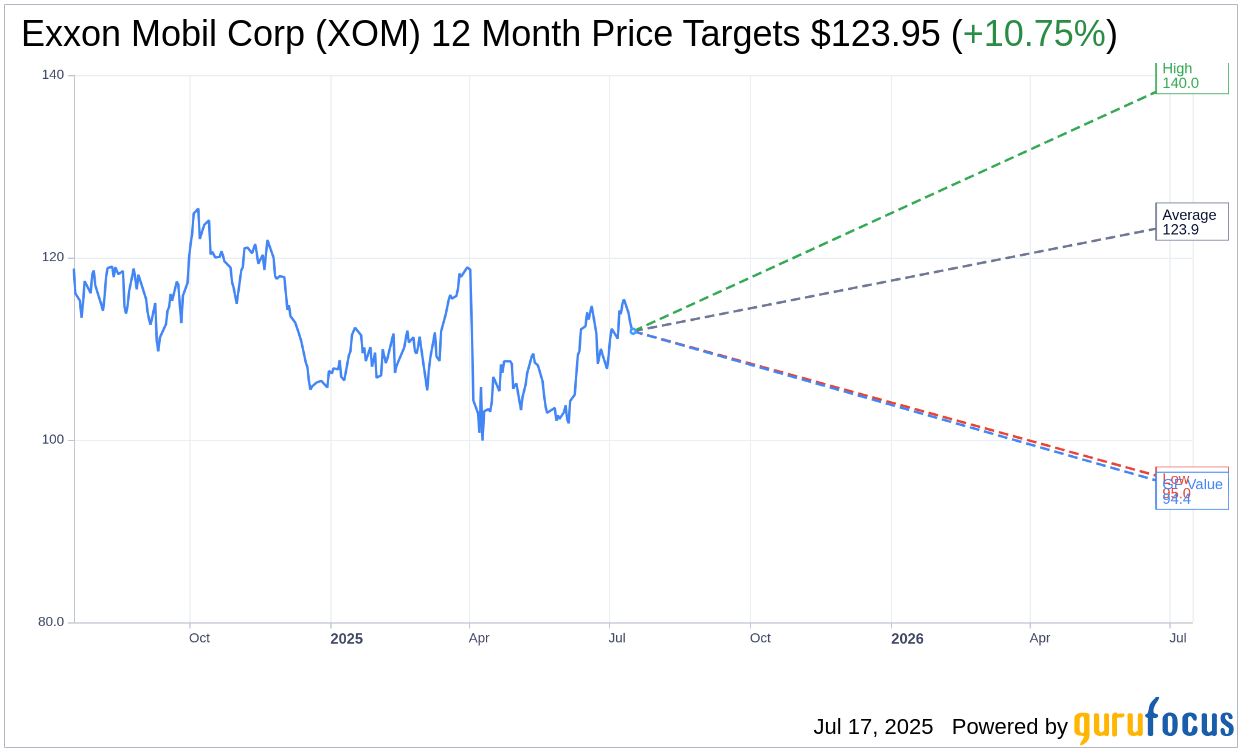Exxon Mobil (XOM, Financial) experienced slight fluctuations as its shares declined by $0.32, reaching approximately $111.91. Options activity was subdued, with around 19,000 contracts exchanged. Call options were more prominent than puts, resulting in a put/call ratio of 0.4, which is lower than the usual level of 0.49.
The implied volatility, measuring future stock price movement, fell by 0.28 to about 22.68, still above the median for the past year. This suggests an anticipated daily price change of $1.60. Additionally, the put-call skew increased, indicating a rise in demand for options that provide downside protection.
Looking forward, Exxon Mobil (XOM, Financial) is set to release its earnings report soon, although the exact date is unspecified. Current options pricing suggests a 50% likelihood of a significant stock move post-earnings.
Wall Street Analysts Forecast

Based on the one-year price targets offered by 24 analysts, the average target price for Exxon Mobil Corp (XOM, Financial) is $123.95 with a high estimate of $140.00 and a low estimate of $95.00. The average target implies an upside of 10.75% from the current price of $111.92. More detailed estimate data can be found on the Exxon Mobil Corp (XOM) Forecast page.
Based on the consensus recommendation from 27 brokerage firms, Exxon Mobil Corp's (XOM, Financial) average brokerage recommendation is currently 2.2, indicating "Outperform" status. The rating scale ranges from 1 to 5, where 1 signifies Strong Buy, and 5 denotes Sell.
Based on GuruFocus estimates, the estimated GF Value for Exxon Mobil Corp (XOM, Financial) in one year is $94.43, suggesting a downside of 15.63% from the current price of $111.92. GF Value is GuruFocus' estimate of the fair value that the stock should be traded at. It is calculated based on the historical multiples the stock has traded at previously, as well as past business growth and the future estimates of the business' performance. More detailed data can be found on the Exxon Mobil Corp (XOM) Summary page.
XOM Key Business Developments
Release Date: May 02, 2025
- Earnings: $7.7 billion, up 4% sequentially, excluding identified items.
- Cash Flow from Operations: $13 billion, leading all IOCs.
- Structural Cost Savings: $12.7 billion removed since 2019.
- Asset Sales: $1.8 billion in the quarter, completing $5 billion of incremental divestments.
- Shareholder Distributions: $9.1 billion, including $4.8 billion in share buybacks.
- Net Debt to Capital Ratio: 7%, leading large cap industrials and IOCs.
- Three-Year Total Shareholder Return: 60%, with a compound annual growth rate of 17%.
- Free Cash Flow: Over 25% of current market cap over the past three years.
For the complete transcript of the earnings call, please refer to the full earnings call transcript.
Positive Points
- Exxon Mobil Corp (XOM, Financial) reported strong quarterly earnings of $7.7 billion, up 4% sequentially, excluding identified items.
- The company generated $13 billion of cash flow from operations, leading all integrated oil companies (IOCs).
- Exxon Mobil Corp (XOM) has achieved $12.7 billion in structural cost savings since 2019, averaging $2.5 billion per year.
- The company has a strong balance sheet with a 7% net debt to capital ratio, leading large-cap industrials and all IOCs.
- Exxon Mobil Corp (XOM) is investing in advantaged projects, including a world-scale chemical plant in China and advanced recycling units, to drive future growth.
Negative Points
- The ongoing uncertainty in tariffs and potential increased OPEC supply are causing significant downward pressure on prices and margins.
- Exxon Mobil Corp (XOM) faces challenges from slowing global growth and rising trade barriers, impacting its chemicals business.
- The company is under pressure to balance short-term investor demands for lower CapEx and higher cash distributions with long-term growth investments.
- Exxon Mobil Corp (XOM) is involved in legal actions, including a lawsuit against the European Union over an unjustified profits tax, which could impact its operations.
- The company faces challenges in securing offtake agreements for its Baytown Blue Hydrogen project, which is critical for its low-carbon strategy.
